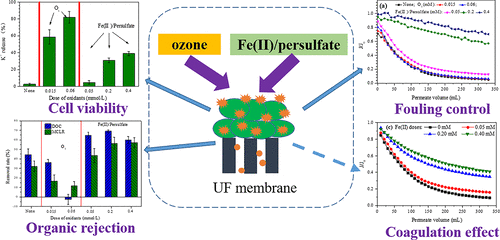当前位置:
X-MOL 学术
›
Environ. Sci. Technol.
›
论文详情
Our official English website, www.x-mol.net, welcomes your feedback! (Note: you will need to create a separate account there.)
Membrane Fouling and Rejection of Organics during Algae-Laden Water Treatment Using Ultrafiltration: A Comparison between in Situ Pretreatment with Fe(II)/Persulfate and Ozone
Environmental Science & Technology ( IF 11.4 ) Pub Date : 2018-01-05 00:00:00 , DOI: 10.1021/acs.est.7b03819 Bin Liu 1, 2 , Fangshu Qu 1 , Huarong Yu 1 , Jiayu Tian 1 , Wei Chen , Heng Liang 1 , Guibai Li 1 , Bart Van der Bruggen 2, 3
Environmental Science & Technology ( IF 11.4 ) Pub Date : 2018-01-05 00:00:00 , DOI: 10.1021/acs.est.7b03819 Bin Liu 1, 2 , Fangshu Qu 1 , Huarong Yu 1 , Jiayu Tian 1 , Wei Chen , Heng Liang 1 , Guibai Li 1 , Bart Van der Bruggen 2, 3
Affiliation

|
In this study, in situ pretreatments with ozone and Fe(II)/persulfate were employed to suppress membrane fouling during the filtration of algae-laden water and to improve the rejection of metabolites. Both ozonation and Fe(II)/persulfate pretreatments negatively impacted the cell integrity, especially ozonation. Fe(II)/persulfate pretreatment improved the removal of dissolved organic carbon and microcystin-LR, but ozonation resulted in a deterioration in the quality of the filtered water. This suggests that the Fe(II)/persulfate oxidation is selective for organic degradation over cell damage. With ozonation, 2-methylisoborneol and geosmin were detected in the filtered water, and the irreversible fouling increased. The intracellular organic release and generation of small organic compounds with ozonation may be the reason for the increased membrane fouling. Fe(II)/persulfate oxidation substantially mitigated the membrane-fouling resistance at concentrations over 0.2 mM compared to the membrane-fouling resistance without oxidation. The combined effect of oxidation and coagulation is likely the reason for the excellent fouling control with Fe(II)/persulfate pretreatment. Membrane fouling during the filtration of algae-laden water is successively governed by complete-blocking and cake-filtration mechanisms. Ozonation caused a shift in the initial major mechanism to intermediate blocking, and the Fe(II)/persulfate pretreatment (>0.2 mM) converted the dominant mechanism into single-standard blocking.
中文翻译:

超滤处理藻类水的过程中膜的污染和有机物的排斥:Fe(II)/过硫酸盐与臭氧原位预处理的比较
在这项研究中,用臭氧和Fe(II)/过硫酸盐进行原位预处理可抑制藻类载水过滤过程中的膜污染,并改善代谢物的截留率。臭氧化和Fe(II)/过硫酸盐预处理均会对细胞完整性产生负面影响,尤其是臭氧化。Fe(II)/过硫酸盐预处理可改善去除溶解的有机碳和微囊藻毒素-LR的能力,但是臭氧化作用导致过滤水的质量下降。这表明Fe(II)/过硫酸盐氧化对有机降解的选择性高于对细胞的损害。进行臭氧化处理后,在过滤后的水中检测到了2-甲基异冰片醇和土臭素,不可逆结垢增加了。细胞内有机物的释放和臭氧化产生的小有机化合物的产生可能是膜污染增加的原因。与未氧化的膜防垢性相比,Fe(II)/过硫酸盐的氧化在浓度超过0.2 mM时显着降低了膜防垢性。氧化和凝结的综合作用可能是用Fe(II)/过硫酸盐预处理进行优异的结垢控制的原因。藻类水过滤过程中的膜污染是由完全阻塞和滤饼过滤机制依次控制的。臭氧化导致了最初的主要机理向中间阻断的转变,Fe(II)/过硫酸盐预处理(> 0.2 mM)将主导机制转变为单标准阻断。与未氧化的膜防垢性相比,Fe(II)/过硫酸盐的氧化在浓度超过0.2 mM时显着降低了膜防垢性。氧化和凝结的综合作用可能是用Fe(II)/过硫酸盐预处理进行优异的结垢控制的原因。藻类水过滤过程中的膜污染是由完全阻塞和滤饼过滤机制依次控制的。臭氧化导致了最初的主要机理向中间阻断的转变,Fe(II)/过硫酸盐预处理(> 0.2 mM)将主导机制转变为单标准阻断。与未氧化的膜防垢性相比,Fe(II)/过硫酸盐的氧化在浓度超过0.2 mM时显着降低了膜防垢性。氧化和凝结的综合作用可能是用Fe(II)/过硫酸盐预处理进行优异的结垢控制的原因。藻类水过滤过程中的膜污染是由完全阻塞和滤饼过滤机制依次控制的。臭氧化导致了最初的主要机理向中间阻断的转变,Fe(II)/过硫酸盐预处理(> 0.2 mM)将主导机制转变为单标准阻断。氧化和凝结的综合作用可能是用Fe(II)/过硫酸盐预处理进行优异的结垢控制的原因。藻类水过滤过程中的膜污染是由完全阻塞和滤饼过滤机制依次控制的。臭氧化导致了最初的主要机理向中间阻断的转变,Fe(II)/过硫酸盐预处理(> 0.2 mM)将主导机制转变为单标准阻断。氧化和凝结的综合作用可能是用Fe(II)/过硫酸盐预处理进行优异的结垢控制的原因。藻类水过滤过程中的膜污染是由完全阻塞和滤饼过滤机制依次控制的。臭氧化导致了最初的主要机理向中间阻断的转变,Fe(II)/过硫酸盐预处理(> 0.2 mM)将主导机制转变为单标准阻断。
更新日期:2018-01-05
中文翻译:

超滤处理藻类水的过程中膜的污染和有机物的排斥:Fe(II)/过硫酸盐与臭氧原位预处理的比较
在这项研究中,用臭氧和Fe(II)/过硫酸盐进行原位预处理可抑制藻类载水过滤过程中的膜污染,并改善代谢物的截留率。臭氧化和Fe(II)/过硫酸盐预处理均会对细胞完整性产生负面影响,尤其是臭氧化。Fe(II)/过硫酸盐预处理可改善去除溶解的有机碳和微囊藻毒素-LR的能力,但是臭氧化作用导致过滤水的质量下降。这表明Fe(II)/过硫酸盐氧化对有机降解的选择性高于对细胞的损害。进行臭氧化处理后,在过滤后的水中检测到了2-甲基异冰片醇和土臭素,不可逆结垢增加了。细胞内有机物的释放和臭氧化产生的小有机化合物的产生可能是膜污染增加的原因。与未氧化的膜防垢性相比,Fe(II)/过硫酸盐的氧化在浓度超过0.2 mM时显着降低了膜防垢性。氧化和凝结的综合作用可能是用Fe(II)/过硫酸盐预处理进行优异的结垢控制的原因。藻类水过滤过程中的膜污染是由完全阻塞和滤饼过滤机制依次控制的。臭氧化导致了最初的主要机理向中间阻断的转变,Fe(II)/过硫酸盐预处理(> 0.2 mM)将主导机制转变为单标准阻断。与未氧化的膜防垢性相比,Fe(II)/过硫酸盐的氧化在浓度超过0.2 mM时显着降低了膜防垢性。氧化和凝结的综合作用可能是用Fe(II)/过硫酸盐预处理进行优异的结垢控制的原因。藻类水过滤过程中的膜污染是由完全阻塞和滤饼过滤机制依次控制的。臭氧化导致了最初的主要机理向中间阻断的转变,Fe(II)/过硫酸盐预处理(> 0.2 mM)将主导机制转变为单标准阻断。与未氧化的膜防垢性相比,Fe(II)/过硫酸盐的氧化在浓度超过0.2 mM时显着降低了膜防垢性。氧化和凝结的综合作用可能是用Fe(II)/过硫酸盐预处理进行优异的结垢控制的原因。藻类水过滤过程中的膜污染是由完全阻塞和滤饼过滤机制依次控制的。臭氧化导致了最初的主要机理向中间阻断的转变,Fe(II)/过硫酸盐预处理(> 0.2 mM)将主导机制转变为单标准阻断。氧化和凝结的综合作用可能是用Fe(II)/过硫酸盐预处理进行优异的结垢控制的原因。藻类水过滤过程中的膜污染是由完全阻塞和滤饼过滤机制依次控制的。臭氧化导致了最初的主要机理向中间阻断的转变,Fe(II)/过硫酸盐预处理(> 0.2 mM)将主导机制转变为单标准阻断。氧化和凝结的综合作用可能是用Fe(II)/过硫酸盐预处理进行优异的结垢控制的原因。藻类水过滤过程中的膜污染是由完全阻塞和滤饼过滤机制依次控制的。臭氧化导致了最初的主要机理向中间阻断的转变,Fe(II)/过硫酸盐预处理(> 0.2 mM)将主导机制转变为单标准阻断。



























 京公网安备 11010802027423号
京公网安备 11010802027423号